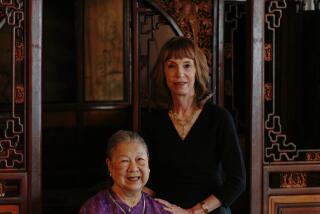Women’s Work : A privileged upbringing gave the author of “Uncle Tom’s Cabin’ not shelter but a sense of social responsibility : HARRIET BEECHER STOWE: A Life, <i> By Joan D. Hedrick</i> ; <i> (Oxford University Press: $35; 507 pp.)</i>
- Share via
It is hard to know how many people read Harriet Beecher Stowe any more or care about her and her tumultuous times. But in her own time, she was the most famous and widely read American writer, a wonder to the world who showed what a woman writing could do. Joan Hedrick’s excellent biography gives the contemporary reader a fresh look at the life of a powerful writer, a genuine moral force and an epochal figure in the modern history of women. Harriet Beecher was born into a celebrity family. It being the 19th and not the late 20th Century, the Beechers’ human drama was framed in terms of religion, reform and literary success and the notorious and scandalous changes rung on those mystic chords. Father Lyman Beecher was a vigorous and self-confident Calvinist whose major project was to stake a claim for the Calvinist faith in the West. His remarkable children included Catherine Beecher, whose career was a working out of women’s role in society through education, and Henry Ward Beecher, an amalgam of Billy Graham, Robert Schuller and Wayne Newton. They crowded the public and domestic stage with vital energy, what Harriet’s husband Calvin Stowe called the Beecher buzz--much like the Kennedys, possessing something chemical, something vital, something troubled and something moral and political.
The Beechers and their projects typified the impulse of educated and religious elites in America’s energetic early national period: To stir popular culture and direct its spread responsibly. Surely Harriet brought this strategy to its apex. Her unique novel, “Uncle Tom’s Cabin,” swept the country and the world with its mixture of feeling and power, with its irresistible drama and its moral force. The very things that struck its critics then strike them now. A book that played less on the familiar strains of racial stereotypes and sentimental convention probably would have had less success in setting antislavery works to the old familiar tunes. The personal and religious sources of “Uncle Tom” also contributed to the book’s unmatched power.
Hedrick shows how Stowe’s own situation as a woman, a writer, a daughter, wife and mother and as a Christian gave her version of the lives of the slaves and their masters such conviction, even as she points out how this version was problematic then and remains so.
But this new biography does something even more important than tell Stowe’s life and do justice to its greatest work. Hedrick has not only done exemplary research, she has also read carefully and with evident passion in the extraordinary scholarship of women’s history and culture that mostly women scholars have produced in the last few decades. Her book retells Stowe’s own story in terms of what has been learned about women’s lives.
Whether discussing Harriet’s experience of the special hardships and illnesses that accompanied women’s lot in the 19th Century and her pursuit of cures for these ills, her relations with her domestic servants, her husband and children, her writing or her audience, Hedrick gives new insight and shape to her story. The way in which, for instance, she connects Stowe’s writing to the parlor culture and its particular style of women’s expression makes Stowe’s writing and that of her peers much clearer. Stowe’s attempts to find a room of her own, as another writer was to put it, and time to write, will be familiar to modern readers. Perhaps less so will be her lifelong search for religious and spiritual meaning in that first new age of American history, in and out of reform movements, periodicals and health regimens. Hedrick’s recounting of the curious and lasting marriage of Harriet Beecher and Calvin Stowe is sensitive and revealing without confusing the historical with the sensational.
Harriet Beecher Stowe outlived her greatest triumph. Her one monumental literary production has always cast its shadow on her other writing. This reviewer was grateful to Hedrick for her accounts of Stowe’s other works. More importantly, Hedrick shows that Stowe’s situation as a woman in the male club of American literature was only briefly alleviated when “Uncle Tom’s Cabin” gave her a readership even misogynist editors and critics dared not ignore. Once her special success in figuring out the public taste was gone, Stowe was left like Rebecca Harding Davis and other women writers of her time, as outsiders to the Literary Establishment and the academic clique that was creating the definition of American literature taught ever since.
*
This part of the biography offers Hedrick’s most incisive analysis and her most pointed language. Hedrick argues as others have that the creation of a literary canon that excluded women writers was part of a strategy that had deliberate and far reaching cultural and gender agendas.
I imagine that there will be those who will find Hedrick’s blending of Stowe’s situation as a woman writer with her limits as a writer too complete. Hedrick’s savaging of Henry James’ savaging of Stowe’s work is savage, but his reputation as a novelist will survive and his tactics as a critic were interesting and, as Hedrick shows, part of a comprehensive disenfranchisement of women writers. This biography will surely direct readers to Stowe’s work; three of her novels are now available in a Library of America volume. It will also help readers to understand why the culture wars continue and will continue because, as Stowe understood, literary ground is contested ground or writing isn’t worth writing or reading.
More to Read
Sign up for our Book Club newsletter
Get the latest news, events and more from the Los Angeles Times Book Club, and help us get L.A. reading and talking.
You may occasionally receive promotional content from the Los Angeles Times.








